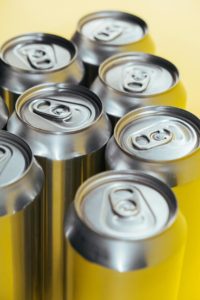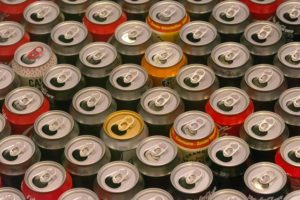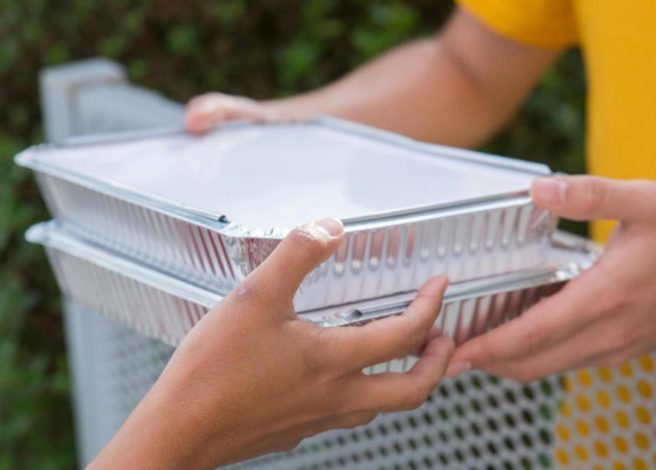Listen to the audio recording of this blog post or check out the featured Podcast about this topic.
At a Glance
- Aluminum and plastic both have unique strengths — aluminum offers high barrier protection and recyclability, while plastics excel in light weight and design flexibility.
- Plastics typically have a lower carbon footprint during production and transport due to their lighter mass.
- Aluminum wins on reuse and infinite recyclability, but can require more energy to produce and recycle.
- Choosing the right packaging means balancing factors like freshness, cost, sustainability goals, and recycling infrastructure.
Food business professionals often face tough choices when picking packaging materials. One of those materials is aluminum. Choosing between aluminum and plastic for packaging affects product look, safety, and sustainability. It also influences costs and how consumers see the brand.
While aluminum might shine in the recycling limelight and plastic keeps winning the lightweight competition, neither deserves a standing ovation without a critical eye.
This week, we had the opportunity to interview Conor Carlin, who founded and currently leads Clefs Advisory LLC. Conor also served as the 2024 President of the Society of Plastics Engineers and previously held the position of General Manager for ILLIG in North America. He has developed significant expertise where packaging and sustainability meet, with his professional work spanning materials, packaging, recycling technologies, policy development, commercial strategy, and market intelligence.
This article cuts through the industry hype and highlights the real benefits and limits of both materials. This information will help you make packaging choices that won’t haunt your quarterly reviews.
Production and Environmental Impact
Raw Material Extraction of Aluminum vs. Plastic
The environmental journey of packaging starts long before that shiny soda can or yogurt container hits the store shelves. It’s like the awkward origin story neither material wants on their resume. 
Aluminum begins as bauxite. This material is mined from the earth in a complex operation. Meanwhile, plastic begins as fossil fuels, requiring oil rigs, as well as drilling and refining operations. Both materials ask Mother Nature to scoot over and make space. They simply pick different areas of her living room to disrupt. The bauxite mines that feed aluminum production create visible scars on landscapes as well as difficult-to-manage waste streams. Oil and natural gas refining, which create precursors for plastic, often happens out of sight. But it rarely escapes environmental impact assessments. Neither material has strong green credentials from the start. This means that even packaging can have complicated backstories.
Manufacturing Energy Requirements
Aluminum production is energy-intensive. The manufacturing process first turns bauxite into alumina, requiring very high temperatures, up to 1250° Fahrenheit in some stages. Alumina is then converted to aluminum via electrolysis. This energy demand leads to more greenhouse gas emissions during production than plastic materials. In fact, these emissions can be 450% higher when compared with plastic.
Plastic production, while less energy-intensive initially, relies on fossil fuel extraction and refinement. Plastic manufacturing is great for food packaging, but, as with all manufacturing processes, we must consider the environmental costs. This includes oil extraction and the emissions that come with it. These factors play a big role in assessing the overall impact. Both materials have significant environmental footprints at different stages of their life cycle.
Recyclability and Circular Economy Potential
Infinite Recyclability vs. Practical Recycling
Aluminum’s standout attribute is its infinite recyclability without quality degradation. No, “infinite recyclability” isn’t some sort of comic book superpower. It means it can be recycled time and time again without breaking down. Approximately 75% of all aluminum ever produced remains in circulation today. Imagine sipping a soda. Now picture some parts of that can belonging to the one from which your grandparent drank from as a teen! Whoever said that packaging couldn’t be wild and fascinating?
According to the Aluminum Association, recycled aluminum saves about 95% of the energy compared to making new aluminum. This gives recycled aluminum a much better environmental profile.

However, not all grades of aluminum are interchangeable in recycling. High-end alloys for aerospace and automotive use can’t be made from recycled beverage cans. Therefore, we still need to extract virgin materials.
Plastic’s recyclability varies significantly by type and recycling infrastructure availability. Some regions recycle PET bottles well, but many plastic packages still struggle to be recycled. New recycling technologies are emerging to tackle these issues. Still, they have not been fully implemented yet.
Collection Economics
The economic value difference between these materials drives divergent collection behaviors. Aluminum is more widely accepted and collected in municipal recycling programs than glass or plastic. It is also easy to sort in material recovery facilities (MRFs) with an established pathway to market at profitable rates.
In simple terms, recovered and recycled aluminum is worth more money than either plastic or glass.
Food Safety Considerations
Untreated aluminum presents challenges for direct food contact. The material can corrode when exposed to certain conditions. This necessitates protective barriers, usually created via alloys where small quantities of other elements are added to aluminum to enhance certain properties. 
Aluminum food packaging, therefore, uses alloys and polymer epoxy coatings. These coatings stop direct contact between the metal and food and act as important barriers to corrosion and migration. However, they also add components that need to meet safety standards.
Plastic food packaging must pass its own set of strict tests and follow food contact rules.
Cost Comparisons
Material Pricing
Aluminum typically costs significantly more than equivalent plastic packaging options. This price gap makes aluminum water bottles available only as premium items or in unique locations like airports.
Plastic is cost-efficient, allowing for mass production worldwide. About 500 billion plastic bottles are made each year. That’s a lot of beverages!
Transportation Economics
Plastic’s lightweight properties translate into lower shipping costs and reduced transportation emissions. For businesses that send out many packaged products, weight differences can change logistics costs.
Application Suitability
Form and Application Factors
Aluminum is great for many uses. It’s perfect for beverage cans and takeout containers with lids. Its rigidity and heat tolerance make it suitable for applications requiring thermal stability.
Plastic has one specific but significant feature over aluminum: clarity. When consumers “buy with their eyes,” they often prefer clear plastic packages. They are more likely to choose this over aluminum containers with lids when food is displayed on the store shelf.
Plastic’s versatility means it can take many shapes, like rigid containers and flexible pouches. This adaptability allows for new packaging designs. However, this flexibility can sometimes lead to lower structural strength than metal containers.
Plastic also has a practical advantage over aluminum. Food in plastic packaging can be resealed after opening, and as you probably already know, food in an aluminum can (like tuna) cannot be resealed without the addition of a commercial plastic lid made by a third party.
Barrier Properties
 Aluminum protects well against light, oxygen, and moisture. This is key for keeping many food products fresh. It blocks light and resists vapor well. This can help sensitive products last longer.
Aluminum protects well against light, oxygen, and moisture. This is key for keeping many food products fresh. It blocks light and resists vapor well. This can help sensitive products last longer.
Different plastic formulations provide varying barrier properties. Some plastics need extra barrier layers or coatings for protection. Others can stay clear and provide enough barrier protection on their own.
Making Strategic Packaging Decisions
Food business professionals must weigh multiple factors when selecting packaging materials:
- Product requirements: Think about the protection needs for your food product. This includes shelf life, light sensitivity, and barrier needs.
- Sustainability goals: Determine your business’s key environmental metrics. Focus on carbon footprint reduction, recyclability, renewable content, or other important factors.
- Cost structure: Look at how material costs influence your pricing strategy and profit margins.
- Consumer expectations: See how packaging affects consumers’ thoughts and their choices to buy in your market.
- Supply chain points: Focus on transportation costs, storage requirements, and disruptions in material supply.
The Material Truth: Choosing for Your Business
 There’s no magic packaging solution that works for every food product — sorry, we checked! What works for your fancy ice cream won’t work for your bargain chips. Your packaging should fit your product perfectly, match your budget well, support your green goals, and make sense for your business.
There’s no magic packaging solution that works for every food product — sorry, we checked! What works for your fancy ice cream won’t work for your bargain chips. Your packaging should fit your product perfectly, match your budget well, support your green goals, and make sense for your business.
By juggling these aluminum and plastic trade-offs like a packaging pro, you’ll make smarter decisions that keep both your customers and your accountants smiling. Remember: the best packaging isn’t just about the material — it’s about making the right call for your unique business recipe.
Are you interested in learning more about plastic food packaging and other materials? Visit our Learning Center today. Have any questions? Don’t hesitate to reach out. We’re here to help!
Would you like to know more about Conor Carlin and his work at Clefs Advisory LLC? Connect with him on LinkedIn today.

